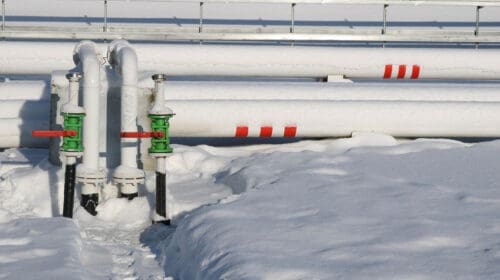Today, oil and gas enterprises such as floating production storage and offloading (FPSO) operators, drilling contractors, and other vessel owners that own and operate large mobile assets must move quicker than ever to take control of project risks and optimize global operations both onshore and offshore in a challenging sector. Here, Colin Beaney, IFS Vice President for Energy, Utilities & Resources, explains how an integrated enterprise software landscape can help oil and gas companies not just achieve greater efficiencies, but integrate emerging technologies that deliver the greatest value.
Emerging technologies such as augmented reality, the Internet of Things (IoT), and digital twins offer significant growth potential to oil and gas organizations operating mobile assets both onshore and offshore. Coupled with this, the complex global supply chain presents opportunities to achieve significant business improvements through better global sourcing and framework agreements, offshore inventory management, and follow-up.
Realizing new value and revenue opportunities will depend on oil and gas organizations’ ability to identify and remove the roadblocks from four business areas in particular – integration of global operations, regulatory compliance, supply chain and asset management, and new technology adoption.
1. Small Data Points Plugged Into a Giant Ecosystem
Many enterprises are now built on a multi-company structure, comprised of an asset-owning entity and multiple geographic operating companies, to operate in different countries and meet various regulations. Remaining connected to relevant, fast-moving external data and being able to analyze and act on it are key in a rapidly shifting global environment. A company’s viability has never been so intrinsically linked to multiple external factors!
To improve business efficiency onshore, finance departments need better support for creating new companies in their systems of record, processing multi-company transactions, and sophisticated reporting and analysis tools to operate across countries, companies, and business units. This requires the enterprise resource planning (ERP) system of these companies to support advanced financial operations and solve any data challenges that arise in the meantime.
Two Essential Ingredients – Data Replication and a Single Source of Truth
One of the major data challenges global mobile asset owners face is real-time communication of transactional information between offshore units and onshore locations. Satellite technology offers a solution here.
Mirroring transactions and activities in an offshore instance with an instance run on the shore side means offshore operations can be supported even in areas with no satellite communication, all while key information is being fed onshore. The data replicated between onshore and offshore operations is highly configurable, but generally includes master data on parts, suppliers, and asset structures, procurement information, financial transactions, and even certain documents such as equipment manuals and schematics. Data replication creates a single version of the truth across the entire organization, no matter how geographically dispersed.
2. Differing Regulations Pose Unique Challenges . . .
Organizations with a global footprint must consider how business processes differ according to region or jurisdiction, such as risk management, quality assurance, health, safety and environment (HSE) management, as well as tax methodology affecting supply chain and spare parts availability.
This is important to keep in mind, as mobile offshore asset operations present unique challenges based on where the vessel is operating. Some tend to set up multiple operating companies to ease tax and regulatory compliance, such as Brazil’s Nota Fiscal, China’s Basic Standard for Enterprise Internal Control, and others. Similarly, decisions about where to house spares and repairs may depend on the resulting tax exposure.
Businesses need to be able to rely on a modern ERP system that streamlines HSE reporting by pulling from operational systems used to maintain and repair assets, but includes integrated quality management and quality assurance functionality.
. . . But Compliance Wins Business in a Globalized World
Beyond financial considerations, companies must also comply with human rights, safety policy, ISO accreditation, and corporate social responsibility (CSR) expectations of governments and stakeholders, including customers and investors. In natural resources-intensive industries, the burden of CSR compliance is increasing, and can be a determining factor in an organization’s ability to operate or to be selected for work in a particular region.
In the global environment the offshore oil and gas industry operates in, these requirements change based on the location of the mobile asset. An enterprise-wide software system must enable teams to ensure compliance in the local waters where the vessel or rig operates. Software should allow operators to act and think both locally and globally, across various regulatory and tax environments.
Business processes are not just multi-company, multi-geography, and multi-language, but cross-company, cross-geography, and cross-language. Supporting software should enable businesses to run a portfolio of projects in multiple currencies and languages, multiple asset service, and supply chain modes in the same application with full visibility and sound governance.
3. Flexible Supply Chain Operations Save Time – and Time Is Money
Speed and agility are at the heart of successful oil and gas operations. Being able to quickly exploit new sources as they are discovered – and move away from less profitable, depleted wells – is essential for survival in the sector. Asset owners will often build new assets or refit existing assets for a new well. From the events associated with asset refit and redeployment to months or years of offshore deployment, oil and gas are a project-intensive business that must be built not around repeatable processes, but unique projects with multiple dependencies, and a focus on real-time tracking of risk, cost, cash, revenue, margin progress, and delivery time. The ability to efficiently manage projects of various sizes, durations, and complexity is crucial for those managing mobile oil and gas assets. But traditional organizational structures and separate legacy software applications make it difficult to understand real-time operational situations, which can lead to costly delays.
It’s All About Enterprise Asset Management (EAM)
To successfully manage the through-life maintenance of mobile assets, operators must structure the business around a network of integrated projects, rather than fixed departmental or geographic silos. For this to run smoothly, contractors must take advantage of rigorous spares and repairs inventory and efficient transport order management functionalities. But it’s all about assets, too. Enterprise solutions must offer not just complete project lifecycle management, but have a focus on financials, materials, subcontracting, human resources, and asset management integrated tightly in the standard functionality used to run projects.
Delivery of equipment and spare parts is a critical activity in complex offshore environments. Parts may be in a supply chain far removed from the unit, with transportation taking days or weeks, or custom fabricated, which again results in long lead times.
Organizations must also consider how equipment is accounted for in a project plan. Enterprise-wide systems should manage this functionality with the head office onshore having complete insight into operational effectiveness and costs as they are incurred. Enhanced visibility will enable oil and gas businesses to shorten idle periods during refits, reduce unplanned downtime, achieve lower tax exposure, as inventory is reduced or allocated to different rigs or vessels to minimize assessments, and, ultimately, increase return on investment on capital assets.
4. Adopting Forward-Thinking Technologies
Artificial Intelligence (AI), digital twins, and augmented reality are among the emerging technologies that pose new business potential for those operating mobile offshore oil and gas assets. But transformational technologies should only be implemented when and where they add real value – preventing unplanned maintenance using IoT or robotics, enhancing spare parts forecasting capabilities, or adding remote communication to upskill staff for instance.
In asset management, examples may include sensor technologies, IoT, and AI to minimize expensive and risky human maintenance intervention and predictive and condition-based maintenance. With an integrated enterprise solution, it is easy to identify the areas where the fine-tuning and optimization benefits these technologies offer can deliver the greatest value.
The Future Favors the Bold
Making informed decisions about large-scale projects, assets, inventory, and transformational technologies is crucial for those managing mobile oil and gas assets in a volatile industry. This requires real-time visibility into the business, including global finance, project and asset management, complex international onshore and offshore supply chain, and offshore asset productivity.
At a critical time for the industry, world-class enterprise systems can help oil and gas organizations achieve these efficiency gains, while also setting them on course for the adoption of emerging technologies where they deliver the greatest value. With innovation, flexibility, and visibility at the core of the enterprise, oil and gas organizations can effectively manage mobile assets to ensure survival and profitability in the long run.
Colin Beaney is the Vice President for Energy, Utilities & Resources within IFS, where he has worked for nearly 20 years. Colin has been involved in implementing and project managing IFS software into many project and asset-intensive organizations in Europe and worldwide. These cover many industries including energy, utilities, pulp & paper, aviation and defense. He is therefore ideally placed to understand the real challenges faced by organizations working in the service and asset-intensive industries. He is a key member of the IFS product directions board and plays an instrumental role in the decisions regarding IFS product strategy. Prior to this, Colin worked as a management consultant specializing in maintenance continuous improvement philosophies such as TPM and RCM. He completed a mechanical engineering apprenticeship many years ago and spent over 15 years working in automotive manufacturing including time as a maintenance and facilities manager.









